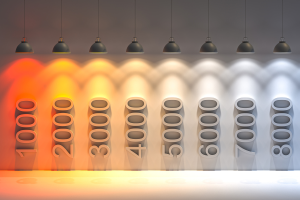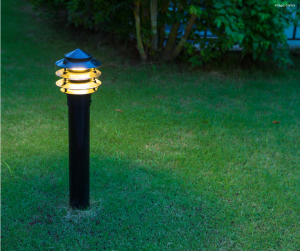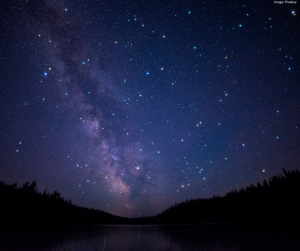by Andres Clavier, Freshwater Stewardship Education Intern
Light pollution is becoming an increasing concern for urban and waterfront dwellers, wildlife enthusiasts, astronomers, and eco-conscious individuals. While we all enjoy the conveniences of over-lit streets, properties, and cities, the unintended consequence has been a sky filled with artificial glow that disrupts wildlife and ecosystems. What if we could have illuminated properties and cities without the negative ecological effects? Effective lighting that does not contribute excessively to light is possible. Here is what to look for the next time you shop for light sources:
Light Temperature
Light sources are categorized by their colour temperature which is measured in Kelvins (K). Lights with a higher Kelvin rating emit a bluish-white light (cool), while those with a lower rating emit a more yellow or amber light (warm). For reducing light pollution, aim for warmer lights, typically 3000K or lower.

Shielded Fixtures
Lights that shine in all directions contribute to skyglow. Instead, opt for full cut-off shielded fixtures. These fixtures ensure light is directed downwards and inwards where needed, rather than into the sky or outwards where the strong, blinding glares can cause safety issues.
Brightness
Bigger is not always better. Choose lights that provide adequate illumination without being excessively bright. Think about the purpose of your lighting. For example, pathway lighting does not need to be as bright as a security light.

Motion Sensors and Timers
Lights left on throughout the night contribute more to light pollution. Consider fixtures with motion sensors so they only light up when needed. Alternatively, timers can ensure lights are turned off during the late hours.
Retrofit Instead of Replace
If you already have outdoor fixtures, consider retrofitting them with shields or warmer, dimmer bulbs instead of buying entirely new fixtures.
Certification
The International Dark-Sky Association (IDA) certifies lighting products that are friendly to our night skies. Seek out products with this seal of approval, and learn more about Dark Sky Preserves and how communities around the world are leading change. Municipalities can also adopt light pollution awareness legislation with specific goals and targets to track progress and impact. Each municipality’s plan will be custom to the needs of the area so there need to be many tools within the legislation to ensure success.
Individual choices make a difference and lead to collective changes which have an even broader impact. Share your knowledge with neighbours and on social media to encourage local businesses, associations, and your municipality to adopt light pollution-friendly practices whenever possible.
Individual choices significantly impact the fight against light pollution and community action has the power to create lasting change. If you are concerned about the artificial glow overshadowing our beautiful Canadian skies and the natural habitats it disrupts, you can make a difference beyond being a wise shopper.
Watersheds Canada’s education toolkit will help you protect our night skies, ensure safer habitats for wildlife, reduce energy consumption, and improve human health by reducing disrupted sleep patterns caused by excessive artificial lighting. Protecting our freshwater areas and the wildlife that live there is important, and it is our collective responsibility to harmonize our actions accordingly. You can do your part by sharing the resources and information from Watersheds Canada’s light pollution awareness campaign!
References
International Dark-Sky Association. (2019). Outdoor Lighting Basics. https://www.darksky.org/lighting/lighting-basics/
This education toolkit is generously funded by:

Education toolkit reviewed by:


